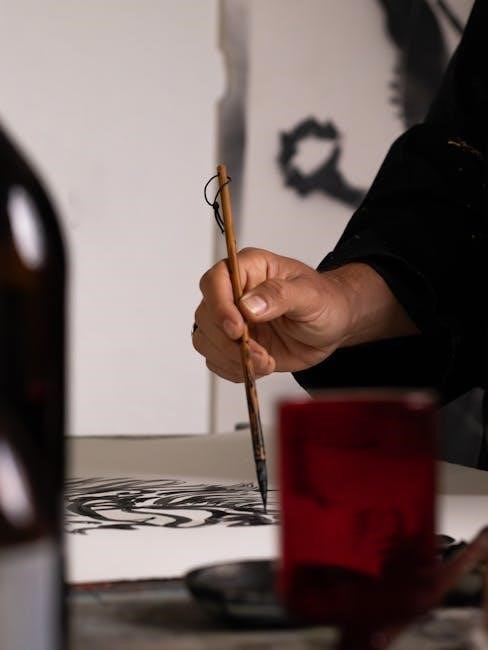The INTERTAN technique is a advanced surgical method for treating complex fractures, particularly in long bones․ It combines precision engineering with minimally invasive approaches to enhance stability and promote healing․ Designed for challenging fracture patterns, the system integrates lag screws, interlocking screws, and a specialized nail to restore bone alignment and function effectively․ This technique is widely recognized for its ability to manage fractures that are difficult to stabilize with traditional methods, offering both immediate and long-term benefits for patients․ By addressing the unique needs of each fracture, the INTERTAN technique has become a cornerstone in modern orthopedic surgery, improving outcomes and reducing recovery times․
What is the INTERTAN Technique?
The INTERTAN technique is a cutting-edge surgical method designed for treating complex fractures, particularly in long bones like the femur․ It involves the use of a specialized nail, lag screws, and interlocking screws to stabilize fractures and promote healing․ The system is engineered to provide exceptional stability while minimizing soft tissue disruption․ The technique is often used in cases where traditional methods fall short, offering a reliable solution for achieving proper bone alignment and facilitating early mobilization․ Its design ensures optimal load-sharing, making it highly effective for challenging fracture patterns․
Importance of the INTERTAN Technique in Modern Surgery
The INTERTAN technique holds significant importance in modern orthopedic surgery due to its ability to address complex fractures with precision and stability․ It minimizes soft tissue disruption, reducing the risk of complications and promoting faster recovery․ The system’s integrated design enhances fracture stabilization, making it ideal for challenging cases․ By providing exceptional stability and resistance to intraoperative errors, the INTERTAN technique improves patient outcomes and restores function and mobility effectively․ Its adoption has revolutionized the treatment of complex fractures, offering a reliable solution in modern surgical practice․
History and Development of the INTERTAN Technique
The INTERTAN technique evolved from earlier fracture treatment methods, incorporating advancements in orthopedic engineering․ Its development focused on improving stability and minimizing complications in complex fractures․ Over time, innovations in screw and nail designs enhanced its effectiveness, establishing it as a reliable surgical solution․
Evolution of Surgical Techniques Leading to INTERTAN
The development of the INTERTAN technique stems from advancements in orthopedic surgery, particularly in fracture management․ Early techniques relied on external fixation and bulky implants, which often led to prolonged recovery and complications․ The introduction of intramedullary nails in the mid-20th century marked a significant shift, providing internal stability with less tissue disruption․ Further innovations, such as interlocking screws and lag screws, enhanced precision and stability․ These advancements culminated in the INTERTAN system, which combines minimally invasive approaches with robust fixation, addressing complex fractures more effectively than its predecessors․
Key Innovations in the INTERTAN System
The INTERTAN system introduces several groundbreaking innovations, including the use of a lag screw for controlled fracture compression and an interlocking screw for enhanced stability․ The nail’s trapezoidal shape ensures a press-fit in the metaphyseal region, optimizing resistance to tensile forces․ These components work synergistically to provide superior fixation, reduce intraoperative errors, and promote faster healing․ The system also features integrated targeting for precise screw placement, minimizing complications and improving surgical accuracy․ These innovations collectively address the limitations of earlier fixation methods, making INTERTAN a highly effective solution for complex fractures․

Key Components of the INTERTAN System
The INTERTAN system comprises three main components: the lag screw, interlocking screw, and the INTERTAN nail․ Each plays a crucial role in fracture stabilization and healing․
The Lag Screw
The lag screw is a critical component of the INTERTAN system, designed to provide fracture compression and promote healing․ Its unique design allows for precise adjustment, enabling surgeons to achieve optimal alignment and stability․ The screw is typically inserted over a guide pin, ensuring accurate placement․ With its ability to compress fractures effectively, the lag screw plays a vital role in restoring bone integrity and facilitating the recovery process․ Its engineering enhances the overall functionality of the INTERTAN technique in treating complex fractures․
The Interlocking Screw
The interlocking screw is a key component of the INTERTAN system, designed to enhance stability and resistance to rotational and bending forces․ Its unique design ensures secure fixation, preventing movement at the fracture site․ This screw is particularly effective in managing complex fractures, where additional support is crucial․ By locking into place, it provides long-term stability, promoting proper bone healing and alignment․ The interlocking screw is essential for maintaining the integrity of the fracture fixation, ensuring optimal surgical outcomes and reducing the risk of postoperative complications․
The INTERTAN Nail
The INTERTAN nail is a central component of the system, designed for intramedullary fixation of long bone fractures․ Its trapezoidal shape ensures a press-fit in the metaphyseal region, providing enhanced stability and resistance to tensile forces․ The nail’s design allows for optimal distribution of stress, minimizing the risk of implant failure․ By maintaining proper alignment and facilitating fracture compression, the INTERTAN nail promotes efficient healing and early patient mobilization․ Its robust construction and precise fit make it a reliable choice for complex fracture management, ensuring long-term stability and functional recovery․

Surgical Indications for the INTERTAN Technique
The INTERTAN technique is primarily indicated for the treatment of long bone fractures, particularly complex or unstable fracture patterns requiring precise alignment and stability to promote healing․
Common Fractures Treated with INTERTAN
The INTERTAN technique is commonly used to treat complex fractures of long bones, such as femoral and tibial fractures․ It is particularly effective for unstable fracture patterns, including those with significant displacement or comminution․ The system is also indicated for fractures requiring precise alignment and stabilization, such as spiral or oblique fractures․ Additionally, INTERTAN is often employed in cases where traditional methods may fail to provide adequate stability, ensuring proper healing and restoring functional alignment to the affected limb․
Contraindications for the INTERTAN Technique
The INTERTAN technique is not recommended for fractures with active infections or severe bone loss․ It is also contraindicated in cases of poor bone quality, such as advanced osteoporosis, where the nail cannot achieve stable fixation․ Additionally, fractures that are non-unions or pathologic in nature may not be suitable for this method․ The technique is also avoided in situations where the fracture pattern does not allow proper nail placement or alignment, or when alternative treatments like joint arthroplasty are more appropriate․

Preoperative Planning and Preparation
Preoperative planning involves detailed imaging assessments and patient evaluation to ensure suitability for the procedure․ Anesthesia planning and surgical team briefing are critical steps․
Imaging and Diagnostic Requirements
Accurate preoperative imaging is crucial for assessing fracture complexity and planning the INTERTAN technique․ High-resolution X-rays, CT scans, and MRIs are commonly used to evaluate bone alignment, fragment displacement, and soft tissue involvement․ These imaging modalities help surgeons determine the appropriate nail length, screw placement, and compression requirements․ Additionally, diagnostic tools like fluoroscopy may be employed during surgery to ensure precise guide pin placement and proper nail positioning, minimizing errors and optimizing outcomes for patients with complex fractures․
Patient Preparation and Anesthesia
Patient preparation for the INTERTAN technique involves standard preoperative protocols, including fasting and medical clearance․ Regional or general anesthesia is typically used to ensure patient comfort during the procedure․ The patient is positioned on a radiolucent table to allow fluoroscopic imaging during surgery․ Antibiotic prophylaxis is administered to reduce infection risk․ Blood loss is minimized with meticulous surgical technique․ The anesthesiologist monitors vital signs throughout the procedure to maintain stability, ensuring a safe and effective surgical experience for the patient․
Step-by-Step Surgical Procedure
- Guide pin placement under fluoroscopic guidance․
- Drilling and insertion of the INTERTAN nail․
- Placement of lag and interlocking screws for stability․
Guide Pin Placement
Guide pin placement is the initial step in the INTERTAN procedure, ensuring precise alignment and accurate nail positioning․ Under fluoroscopic guidance, the surgeon inserts a guide pin into the fracture site, following the predefined trajectory․ Proper positioning is critical to avoid complications and achieve optimal fracture reduction․ The pin serves as a reference for subsequent steps, including drilling and nail insertion․ Accurate placement ensures minimal soft tissue damage and facilitates stable implant positioning, which is essential for effective fracture healing and patient recovery․ This step sets the foundation for the entire procedure’s success․
Drill and Nail Insertion
Following guide pin placement, the surgeon uses a drill to create a pathway for the INTERTAN nail․ The drill bit is guided by the pin to ensure precise alignment․ Once drilled, the nail is carefully inserted along the same trajectory, leveraging its trapezoidal design for press-fit stability in the metaphyseal region․ This step is critical for achieving proper alignment and load-sharing capabilities․ Fluoroscopic imaging is used throughout to confirm correct positioning, ensuring the nail is seated correctly to promote optimal fracture stability and healing outcomes․ This precise insertion minimizes the risk of malpositioning and enhances surgical success․
Lag Screw and Interlocking Screw Placement
After nail insertion, the lag screw is adjusted based on the measured length and desired fracture compression․ For instance, if the guide pin indicates 105mm and 5mm of compression is required, the screw is set accordingly․ The interlocking screw is then placed to enhance stability, preventing rotation or collapse․ This step ensures proper alignment and load-sharing, crucial for fracture healing․ Fluoroscopic imaging is used to confirm accurate placement, minimizing complications and optimizing surgical outcomes․ This dual-screw system is integral to the INTERTAN technique’s effectiveness in complex fractures․

Postoperative Care and Management
Postoperative care involves monitoring for complications, managing pain, and initiating early mobilization․ Physical therapy begins to restore function and strength, ensuring proper healing and minimizing risks of complications․
Immediate Postoperative Care
Immediate postoperative care focuses on monitoring the patient for complications, managing pain, and ensuring wound integrity․ Patients are typically immobilized to protect the fracture site, and pain is controlled with prescribed medication․ Regular neurological and vascular checks are performed to ensure proper limb function․ Dressings are kept clean, and early mobilization is encouraged to prevent stiffness․ Antibiotics may be administered to reduce infection risks․ Strict adherence to postoperative protocols helps minimize complications and promotes optimal healing outcomes following the INTERTAN procedure․
Physical Therapy and Rehabilitation
Physical therapy and rehabilitation are crucial for restoring mobility and strength after the INTERTAN procedure․ A tailored program is designed based on the fracture severity and patient’s overall condition․ Early mobilization is emphasized to prevent stiffness and promote healing․ Patients typically begin with range-of-motion exercises and gradually progress to weight-bearing activities․ Strength training is introduced to restore muscle function and improve joint stability․ Regular follow-ups with the healthcare team ensure proper recovery and address any challenges during the rehabilitation process․ The goal is to achieve pre-injury function and mobility levels․
Follow-Up and Monitoring
Follow-up and monitoring are essential to ensure proper healing and address potential complications after the INTERTAN procedure․ Regular clinical evaluations are scheduled to assess fracture union, alignment, and functional recovery․ Imaging studies, such as X-rays or CT scans, are used to monitor bone healing progress․ Pain and mobility assessments are conducted to guide rehabilitation adjustments․ Any signs of complications, like hardware failure or infection, are promptly identified and managed․ A coordinated approach between the surgical team and physical therapists optimizes patient outcomes and ensures a smooth recovery process․

Potential Complications and Management
Potential complications include hardware failure, infection, or improper nail placement․ Management involves revision surgery, antibiotic therapy, or adjusting the nail to ensure proper alignment and healing․
Common Surgical Complications
Common complications include hardware failure, such as nail breakage or screw loosening, and infection․ Improper placement of the INTERTAN nail or screws can lead to malalignment or nerve damage․ Infection risks are mitigated with antibiotics, while hardware issues may require revision surgery․ Additionally, patients may experience discomfort or limited mobility postoperatively․ Early detection and management are crucial to prevent long-term functional impairment․ Proper surgical technique and patient selection are key to minimizing these complications and ensuring optimal outcomes․
Postoperative Complications and Solutions
Postoperative complications may include hardware failure, infection, or delayed healing․ Hardware issues, such as nail breakage, can be addressed with revision surgery․ Infections are managed with antibiotics or surgical debridement․ Proper wound care and patient compliance with rehabilitation protocols are crucial to prevent these issues․ Regular follow-up appointments ensure early detection of complications, allowing timely intervention․ Physical therapy is often prescribed to restore mobility and strength, promoting a full recovery․ Adherence to postoperative care guidelines minimizes risks and enhances overall outcomes for patients undergoing the INTERTAN technique․

Clinical Outcomes and Success Rates
The INTERTAN technique demonstrates high success rates in managing complex fractures, with improved patient outcomes, reduced complication rates, and faster recovery times compared to traditional methods․
Studies on the Effectiveness of INTERTAN
Clinical studies have consistently demonstrated the effectiveness of the INTERTAN technique in achieving high union rates and stable fracture fixation․ Research highlights its ability to provide superior stability, particularly in complex fracture patterns, reducing the risk of postoperative complications․ The system’s integrated interlocking screw option has been shown to enhance resistance to rotational and axial forces, improving patient outcomes․ These studies underscore the INTERTAN technique’s role in modern orthopedic surgery, offering a reliable solution for challenging fractures with minimal invasive approaches․
Case Studies and Real-World Applications
Real-world applications of the INTERTAN technique have demonstrated its efficacy in managing complex fractures․ For instance, a salvage procedure using INTERTAN successfully avoided joint arthroplasty, showcasing its versatility․ Clinical cases highlight its effectiveness in treating fractures with significant bone loss or instability․ Surgeons have reported consistent outcomes, with patients achieving faster recovery and reduced complications․ These applications underscore the technique’s practical benefits in diverse surgical scenarios, making it a valuable tool in orthopedic practice․

Advantages of the INTERTAN Technique
The INTERTAN technique offers improved fracture stability, minimizes tissue damage, and reduces recovery time․ Its interlocking system enhances resistance to intraoperative errors, while the nail design provides optimal bone alignment and healing․ The minimally invasive approach lowers risk of complications and promotes faster patient mobility․ These advantages make it a preferred method for treating complex fractures, especially in challenging cases where traditional techniques may fall short․
Improved Stability and Healing
The INTERTAN technique excels in providing exceptional stability to fractures, particularly in complex cases․ By utilizing a combination of lag screws and interlocking screws, it ensures proper bone alignment and compression, which are critical for healing․ The system’s design distributes stress evenly, minimizing the risk of postoperative complications such as nail migration or fracture collapse․ This enhanced stability fosters an optimal environment for bone union, leading to faster recovery times and better clinical outcomes compared to traditional methods․ Patients often experience reduced pain and improved mobility post-surgery․
Minimally Invasive Approach
The INTERTAN technique employs a minimally invasive approach, utilizing smaller incisions and precise instrumentation to minimize tissue damage․ This method reduces surgical trauma, leading to less postoperative pain and a faster recovery․ The precise placement of screws and nails ensures accurate alignment with minimal disruption, lowering the risk of complications․ Patients benefit from shorter hospital stays and reduced rehabilitation time, making the INTERTAN technique a preferred choice for treating complex fractures with a focus on patient comfort and effective outcomes․
Reduced Risk of Intraoperative Errors
The INTERTAN technique significantly reduces the risk of intraoperative errors through its intuitive design and precise targeting mechanisms․ The system’s press-fit and real-time feedback features ensure accurate placement of screws and nails, minimizing misalignment․ This advanced engineering allows surgeons to achieve optimal fracture stabilization with fewer technical mishaps․ The integrated interlocking screw option further enhances stability, reducing the likelihood of intraoperative complications․ These features collectively contribute to a more reliable and safer surgical experience, ultimately improving patient outcomes and procedural success rates․

Limitations of the INTERTAN Technique
The INTERTAN technique has limitations, including technical challenges, a steep learning curve for surgeons, and high costs, making it less accessible in some regions․
Technical Challenges
The INTERTAN technique presents several technical challenges, including precise guide pin placement and nail positioning․ Surgeons must ensure accurate targeting to avoid misalignment, as improper placement can lead to instability or complications․ The system’s design requires careful handling of the lag screw and interlocking screw to achieve optimal fracture compression and stability․ Additionally, the minimally invasive approach demands advanced imaging and navigation skills to visualize the fracture site effectively․ These technical demands highlight the need for specialized training and experience to master the INTERTAN technique successfully․
Learning Curve for Surgeons
The INTERTAN technique requires a steep learning curve due to its complexity and precision demands․ Surgeons must master guide pin placement, nail insertion, and screw positioning to ensure proper alignment and stability․ The system’s reliance on advanced imaging and minimally invasive techniques adds to the challenge, necessitating extensive training and hands-on experience․ Additionally, understanding fracture patterns and selecting the appropriate nail size are critical skills that require time to develop․ The psychological pressure to perform accurately under operating conditions further intensifies the learning process, making it essential for surgeons to undergo specialized training and mentorship before confidently applying the technique in clinical settings․
Cost and Accessibility Issues
The INTERTAN technique is associated with high costs due to its advanced technology and specialized components․ The system requires expensive instrumentation, including nails, screws, and drills, which can strain hospital budgets․ Additionally, the need for advanced imaging systems and trained personnel further increases expenses․ Accessibility is limited in regions with resource constraints, making it difficult for patients in underserved areas to benefit from this technique․ The financial burden on healthcare systems and patients underscores the need for alternative solutions or subsidies to improve accessibility and affordability․

Recent Advancements in the INTERTAN Technique
Recent advancements include new materials, advanced imaging systems, and innovative surgical instruments, enhancing precision and improving patient outcomes significantly․
New Materials and Technologies
Recent advancements in the INTERTAN Technique include the development of advanced biocompatible materials, such as titanium alloys and fiber-reinforced polymers, which enhance durability and reduce complications․ Innovations in nail design, including temperature-responsive materials that adjust stiffness, improve stability in complex fractures․ Additionally, 3D-printed customized nails are now being integrated, offering precise fit and enhanced outcomes․ These technological improvements ensure better compatibility with patient anatomy, minimizing risks and promoting faster recovery times while maintaining the technique’s minimally invasive benefits․
Advanced Imaging and Navigation Systems
Advanced imaging and navigation systems have significantly enhanced the precision of the INTERTAN Technique․ Intraoperative 3D fluoroscopy and augmented reality (AR) tools provide real-time visualization, improving screw placement accuracy․ AI-driven analytics optimize preoperative planning by predicting potential complications․ Additionally, these systems enable customizable templates for complex fractures, reducing operative time and intraoperative errors․ Integration with robotic-assisted platforms further elevates the technique’s accuracy, ensuring minimal invasiveness and superior outcomes․ These innovations represent a leap forward in surgical precision, aligning with modern demands for enhanced patient care and operational efficiency․
Innovative Surgical Instruments
Innovative surgical instruments, such as the INTERTAN Lag Screw Drill (7167-4540), enhance the precision of the INTERTAN Technique․ These tools are designed to ensure accurate placement of the lag screw and interlocking screw, minimizing intraoperative errors․ The trapezoidal shape of the INTERTAN Nail provides a press-fit in the metaphyseal region, increasing stability and resistance to tensile forces․ These instruments are engineered to improve surgical accuracy, enabling precise fracture compression and alignment․ Their design reflects advancements in orthopedic instrumentation, aiming to optimize surgical outcomes and patient recovery․
The INTERTAN Technique represents a significant advancement in orthopedic surgery, offering precise and effective fracture management․ Its innovative design and clinical success underscore its value in modern surgical practices, with promising future developments expected to further enhance its capabilities and accessibility․
The INTERTAN Technique is a cutting-edge surgical method designed for managing complex fractures, particularly in long bones․ It utilizes a specialized nail system combined with lag and interlocking screws to provide exceptional stability and promote proper healing․ This technique is highly effective for fractures that are challenging to treat with conventional methods, offering both immediate stabilization and long-term recovery benefits․ Its minimally invasive approach reduces tissue damage, while its precise engineering ensures optimal alignment and load-sharing, making it a preferred choice in modern orthopedic surgery for improving patient outcomes․
Future Prospects and Potential Developments
The INTERTAN Technique is poised for further advancements, with ongoing research focusing on new materials and technologies․ Future developments may include enhanced nail designs for improved load-sharing and customizable solutions for complex fractures․ Integration with advanced imaging and navigation systems could further refine accuracy and reduce surgical errors․ Additionally, innovations in surgical instrumentation and minimally invasive approaches are expected to expand the technique’s applications․ These advancements aim to improve patient outcomes, making the INTERTAN Technique even more versatile and effective in orthopedic surgery․



